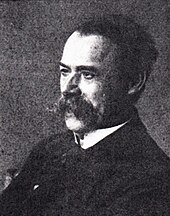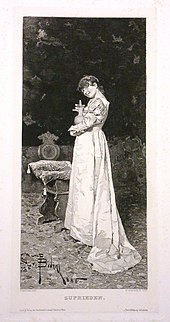Wilhelm Woernle
Wilhelm Woernle (born January 23, 1849 in Stuttgart , † March 24, 1916 in Vienna ) was a German - Austrian painter and graphic artist who was best known as a reproduction eraser.
Life
The son of a plasterer and decorative painter completed an apprenticeship in copperplate engraving with Veit Froer ( 1828-1900 ) in Stuttgart from 1863 to 1867 , where he also learned the technique of etching . At the same time he attended the Stuttgart art school under Bernhard Neher . After completing his apprenticeship, the young man hired himself out in Adolf Wagenmann's (1839 -?) Studio to work on reproduction stitches. He soon gave up trying to work independently as an engraver in order to devote himself to painting in Munich under the direction of Heinrich Zügel (1850–1941), with whom he had been friends at the Stuttgart art school. In 1873 he went on a two-year study trip to Italy. Mostly in Venice he created paintings, watercolors and drawings, which he offered as templates for woodcuts. When the Emperor of Austria made a state visit to Venice in 1875, Woernle supplied large-format illustration drawings for the “ Illustrierte Zeitung ” in Leipzig, which were widely used as woodcuts. In 1875/76 he returned to Munich and married in January 1877. In addition to landscape painting, he returned to etching. Probably at the suggestion of Heinrich Zügel , Woernle was able to publish a small etching after the painting by his painter friend “Nobody at home” for the first time in the renowned “Zeitschrift für bildende Kunst” in 1878. The painterly designed etching with delicate valeurs was widely recognized and from then on the EA Seemann publishing house regularly published Woernle's etchings based on old and contemporary masters in the magazine for visual arts. The Association for Reproductive Art in Vienna also became aware of Woernle and commissioned him with the reproduction of selected works from the Budapest State Painting Gallery. This and the prospect of further orders from the association prompted Woernle to settle permanently in Vienna in 1879. Here he met William Unger (1837-1932), the "artistic father" of painterly reproduction etching, who helped him perfect the etching technique. When Unger had to interrupt his teaching activities for etching techniques at the Vienna School of Applied Arts for a year in 1881, he appointed Woernle to represent him. In 1882 his collaboration as an etcher on Carl von Lützow's “The Art Treasures of Italy” brought him back to Italy. In addition, he delivered reproduction etchings for “ Die Graphische Künste ” in rapid succession and fulfilled duplication orders for private collectors in Vienna and Prague. In 1883 an “International Exhibition of Graphic Arts” was held in Vienna, devoted exclusively to reproduction graphics. Woernle was able to draw attention to himself with several works. In 1885, King Karl von Württemberg awarded him the gold medal for art and science for the large-format etching on satin silk "Jesus Christ" after the painting by Gabriel von Max . Along with William Unger, Peter Halm (1854–1923), Ludwig Kühn (1859–1936) and Doris Raab (1851–1933), Woernle was one of the most famous reproduction erasers in German-speaking countries. In the early 1990s he was commissioned to reproduce handicraft objects from the 19th century at the Austrian Museum of Art and Industry . Woernle supplied 20 color etchings for the folder, which was published in a small edition. According to his own statement, he had redeveloped the forgotten technique of color etching around 1890. In the mid-1990s, as photographic techniques improved, the need for reproduction etchings decreased and soon came to a complete standstill. Woernle avoided working on heliogravures . Between 1901 and 1905 the Viennese company Heck commissioned him with large-format original etchings by musicians and poets. Wilhelm Woernle died on March 24, 1916 at the age of 67 in Vienna.
Create
Woernle's complete oeuvre comprises around 125 etchings based on paintings from the 16th to the late 19th century, including 20 etchings based on paintings in the Landesgalerie Budapest (now the Museum of Fine Arts Budapest) and at least 13 reproduction etchings after Italian masters in Carl v. Lützow s "Artworks of Italy". In addition, he created around 20 color etchings based on sculptures and sculptures in the arts and crafts museum in Vienna. Of the reproductions by contemporary German and Austrian artists, the etchings by Kaulbach , Max , Makart , Zügel and Klimt deserve special attention. This also includes 8 sheets after mural paintings in the Vienna Burgtheater , which are kept in the National Gallery in Prague.
Numerous, even large-format sheets impressively testify to Woernle's special ability to reproduce paintings in mirror image using the etching technique with almost photographic accuracy. Seldom happily, his works combine the strict discipline of the engraving school with a deeply painterly perceived etching technique to create finely perceived painting copies by old and new masters.
At least 15 original etchings, a few drawings and more than 10 paintings and watercolors are known by Woernle. The latter mostly originated in the 1870s.
literature
- Constantin von Wurzbach : Wörnle, Wilhelm . In: Biographisches Lexikon des Kaiserthums Oesterreich . 57th part. Kaiserlich-Königliche Hof- und Staatsdruckerei, Vienna 1889, p. 226 ( digitized version ).
- Woernle, Wilhelm. In: Friedrich von Boetticher: painter works of the 19th century. Contribution to art history. Volume 2/2, sheets 33–67: Saal – Zwengauer. Ms. v. Boetticher's Verlag, Dresden 1901, pp. 1039-1040 ( archive.org ).
- Adalbert Roeper: Wilhelm Woernle. For the artist's sixtieth birthday. In: Börsenblatt des Deutschen Buchhandels. No. 18 of January 23, 1909, pp. 960–966 (with compilation of works).
- Woernle, Wilhelm . In: Hans Wolfgang Singer (Ed.): General Artist Lexicon. Life and works of the most famous visual artists . Prepared by Hermann Alexander Müller . 5th unchanged edition. tape 5 : Vialle-Zyrlein. Supplements and corrections . Literary Institute, Rütten & Loening, Frankfurt a. M. 1921, p. 115–116 ( Textarchiv - Internet Archive - and addendum in volume 6 p. 302 on the day of death).
- Friedrich Jansa: German visual artists in words and pictures. Leipzig 1912, p. 645 f.
- Woernle, Wilhelm . In: Hans Vollmer (Hrsg.): General lexicon of fine artists from antiquity to the present . Founded by Ulrich Thieme and Felix Becker . tape 36 : Wilhelmy-Zyzywi . EA Seemann, Leipzig 1947, p. 171 .
- HA Lier: On the history of modern etching. Carl von Lützow (Hrsg.): Journal for fine arts. New series, 6th year, EA Seemann, Leipzig 1878, pp. 227–236 and 252–263, here p. 235 Textarchiv - Internet Archive .
- Society for duplicating art (ed.): Die Graphischen Künste. Vienna 1879–1916.
- Carl von Lützow: The art treasures of Italy. Stuttgart 1884.
- Kunstgewerbeschule of the KK Austrian Museum for Art and Industry (Ed.): Works of the Austrian art industry from the years 1868 to 1893. (5 folders), Vienna 1893.
Web links
Individual evidence
- ↑ William Unger: From my life . Vienna 1929, p. 191 .
- ↑ In a personal letter to his nephew on January 24, 1909, Woernle describes the technique of his color etching, which he “redesigned” and was the first to have done again.
| personal data | |
|---|---|
| SURNAME | Woernle, Wilhelm |
| ALTERNATIVE NAMES | Woernle, W .; Woernle, Wilhelm |
| BRIEF DESCRIPTION | German-Austrian painter and graphic artist |
| DATE OF BIRTH | January 23, 1849 |
| PLACE OF BIRTH | Stuttgart |
| DATE OF DEATH | March 24, 1916 |
| Place of death | Vienna |





